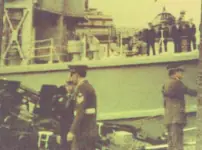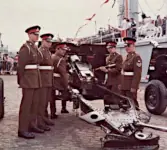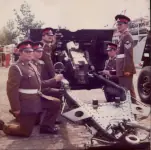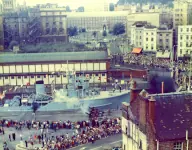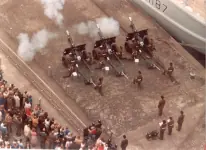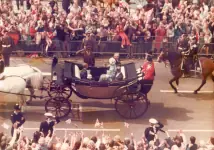266 (GVA) O.P. Bty R.A. (V)
1977
In 1971, 266 (Gloucestershire Volunteer Artillery) Observation Post Battery was formed as an independent Observation Post unit as a reinforcement unit for the British Army of the Rhine (BAOR) supplying observation post teams. The battery had a four gun troop of 25pdr field guns. In time of war the battery would provide 18 Observation Post Parties, later amended to 22, to regular army units.
March/April 1977 - 3rd Royal Tank Regt Battlegroup, BATUS
An observation post party from 266 (GVA) O.P. Bty R.A. (V) was sent on attachment to 171st Bty 32nd Regt R. A., based at Bulford Camp, for 5 weeks camp at the British Army Training Unit Suffield (BATUS), Alberta, Canada. BATUS is generally regarded as the British Army's largest training field in the world and it can accommodate live-firing exercises up to the Brigade level. It is situated some 48 kms west of Medicine Hat, Alberta and approximately 257 kms south east of Calgary. The surrounding countryside is flat, grassy prairie.
This is Derek Driscoll's memory of the exercise:
The O.P. Officer was Capt Eduardo. A. Guerrero, (later Lieutenantt-Colonel E. A. Guerrero, OBE, JP) on attachment from the Royal Gibraltar Regiment.
The O.P. Party From 266th (GVA) O.P. Bty R.A. (V) for BATUS consisted of Sgt Derek Driscoll, Bdr Dennis Dyer, L/Bdr Ben Martin, L/Bdr Harry Harris and Gunner Martin Green we were lucky enough to have a few days training on the Plain before leaving for Canada, Captain Guerrero was congratulated by the Instructor Gunnery (I.G.) for the fire plans that we undertook.
On leaving the U.K. at Brize Norton, we were lucky enough to get on the last V.C.10 out, it turned out that the next plane was a Hercules which meant a long stop over at Gander, Newfoundland and Labrador, Canada, before taking off the next day, so adding an extra day to the journey, also when we landed at Gander the scene was to say bleak, very cold and windy.
On arrival at Calgary we deplaned and took a coach to Suffield Camp, where we ate the biggest steaks I had ever seen, after settling in the men, I found my allotted bed space in the Sgt's mess quarters.
The next day we were shown our AFV 432, which had more dust inside then out, having cleaned out the vehicle of mountains of dust we started to adjust the tracks and fit the radios we then filled the 432 with fuel and took it out on the ranges for a familiarization shake down. We found that the AFV 432 was running O.K. and we managed to get our bearings around the camp perimeter. On returning to camp we showered and had dinner afterwards we spent time in the N.A.F.F.I. the adverts on the local T.V. station were not like the ones in the U.K., all flashy and bright colour 's, no they just wrote on a piece of card in black felt tip pen "Best prices at Johnson's Grocery Store" and placed it in front of the camera very amateurish but never the less effective.
The first week of training also took in a fire power demonstration including Tanks direct and indirect fire, Artillery, Helicopters, Giant Viper/Python mine clearance and Infantry support weapons which included Mortars and Heavy Machine Gun fire, a fire broke out in the Mortar Sanger and it was a race against time to clear the ammunition to a safe place, the fire spread very quickly on the range and it had to be put out using very large water bowzers, we also had a night time Fire Power Demonstration this was very impressive and just like a very large fantastic firework display. the tanks put on their searchlights to show how effective they were.
Wildlife on the ranges. White-Tailed Deer, Rabbits, Ground squirrel, Chipmunk, Striped Skunks, Rattle Snakes and Eagles and also a very diverse flora and fauna, when it rained at night you awoke next morning to a carpet of yellow cactus flowers. On one of the range familiarization days we went to inspect a tree on the prairie, there are not many trees on the prairie and those of a certain height were marked on the maps, as we got near we saw a nest in the tree, as we got nearer to the nest, we thought that we would wait awhile to see if the mother Eagle would return and she did, swooping and diving at us from a great height, we beat a hasty retreat and so would you if you saw the Talons on her. We stopped by a old ruin which was a farm house, just the footings were left, but to the rear of the building we came across the remains an old Model "T" Ford which looked as if it had been in a sandblaster as we could not find a bit of rust on it.
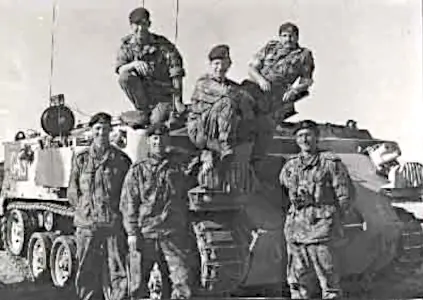
On exercise at BATUS
Left to Right Top: L/Bdr Harry Harris, Gnr Martin Green, L/Bdr Ben Martin
Standing: Bdr Dennis Dyer, Sgt Derek Driscoll, Capt Eduardo A. Guerrero. Gibraltar Regt.
It seemed all to soon before we had to report ready in all respects and the time of the "O" group was given and early the next morning we were off in convoy across the rolling prairie to start the war games, the BATUS area was used after the second world war, as a test site for the atomic/chemical tests by the British Army and there are roads running in a circle around the center point 5 mile ring road, 10 mile ring road, etc.
We were now on exercise and the armoured vehicles sent up a very large dust cloud, so we closed all the hatches, when we got to our area of operations we noticed that we were all covered in dust, the seals on the hatches were u.s. that evening we laagered up with the B.C. of our Bty, Major Iain Johnstone [now retired Brig] who came knocking on the back door of the 432 "Hello my Gloucestershire Heroes" he shouted, we offered him tea and he spent some time with us in the back of the 432 giving us a briefing as to what was going to happen in the morning and what he expected of us.
The next few days were a bit of a bore, as we found the locations of the other units that we were to support and they put us in bunkers that had been dug by the R. E's with no revetting, as the earth was frozen by the permafrost, and after an hour or so we got the order to move, this went on for the next two days. The previous evening the weather turned for the worst rain and hailstones the size of which astounded me, I had never seen hailstones that big before. As the darkness increased we could see in the distance a electric storm coming our way, what a site that was sheet and fork lightening like in and the others in the party have never seen before, and it went on for a long time, the lightening started a fire on the prairie and the water bowzers were sent to put the fire out, this was not the last time we would see the range on fire.
The reason it took so long for the guns to fire was that the ammo for the guns was stuck on the east coast, and ammo had to be barrowed from the Canadians, the paper work was endless or so I was informed.
We went on training like this for a week, and then the battle really started fire missions were coming down to the command post in quick succession and the guns were very accurate we took part in a danger close mission which was a bit frightening, all those H.E. rds landing very close to our trenches (100m). We also did a night shoot which was very successful, that night Capt Guerrero ate a steak by kind permission of the I G, in fact the steak was meant for the BC, Major Iain Johnstone, who was not amused.
The second weekend of the exercise the sky opened and the rain came down in buckets so much so the Battlegroup was halted as the roads around the area were dangerous for vehicle movements, as the dust was turned into a mud slurry by the rain.
It was about this time that L/Bdr Ben Martin reported to me that Gunner Martin Green was not at all well, we called the medic who said he was a very ill man and would have to be casevac to hospital in Medicine Hat, as he was airlifted out, we got back into the swing of things, until a message came to the bty that all personnel were to stay put and the exercise was stopped. Later that day a Medical team came and took swabs from all our mouths it turned out that Gnr Green had meningitis, sometime during the next day we heard that it was the BC's driver who had passed on this illness he was a carrier of the disease, he did not know he was a carrier, the whole unit had to be quarantined and have swabs taken and it shut the whole battle group down for a few days.
After the Medics gave the all clear, the exercise was restarted and before we moved to a new starting/ jumping off point we had to refuel. This was the first time I had experienced a whole Battlegroup re-supply area and it was a site to behold as the units lined up and refueled from Jerry cans, we had to ground/earth the 432, so as to stop a potential fire hazard through static electricity.
We were now over half way though the exercise and we took part in a attack on the RED Forces this started with a breach being blown in the defences they said it would be loud and it was very loud, the Battlegroup passed through the breach and on to the plain beyond attacking the RED forces. A break was called and the whole Battlegroup stood down for a general admin clear up, some of the men were offered a shower but they had to go back to the main camp so my crew voted to stay behind and clear out the 432 and repack the kit. Cooking was a bit of a doodle we would use the boiling vessel situated on the back door of the 432 and used plates, with Knives and forks to eat with, not like the poor Infantry who would sit around the boiling vessel and each with a spoon would help themselves in strict order. We would also use the exhaust on the top of the 432 to warm up the tins of Compo, just let the engine idle and then when ready just put your foot down on the accelerator and the tin would fly out of the exhaust in a puff of blue smoke.
The BC's Tent was set on fire by a smoker (BC's driver) who fell asleep and set fire to his sleeping bag, the amount of kit that was written off was very large, coats, sleeping bags. beds, uniform and tentage, the ensuing fire quickly spread across the prairie with the wind behind it we could not do anything to stop the fire racing away. The water bowzers were sent in to put out the fire by the time they arrived on the scene the fire had burnt the prairie as far as the eye could see.
On our last day we were given orders to support an infantry attack, the ground was very rough and undulating and it was very hot we were climbing a small hill and Capt Guerrero called for a fire mission we adjusted the target and called for 3 rds fire for effect at the end of the mission, the B.C. congratulated us over the radio saying to all that a fire mission on foot was not impossible, just a little difficult. The exercise ended with a final assault with live ammo with support from Canadian Air Force Fighters. One of the highlights of the day was to watch the O.C Tangier Company, 1 Queens, taking his ablutions in a wash basin totally naked!
Afterwards we got the message we all looked forward to "END EX" getting back to camp and having a shower was fantastic we had orders to be on parade at 8 o'clock the next morning, on the parade we were told to hand in all the kit and prepare the 432 for the next Battlegroup we had to take one link out of the tracks as they had stretched, we also had to check all the fluid levels and replenish as necessary, all the small vehicle tools had to be cleaned and handed in as was the radio kit (C45, B48, A41 and A42 - all Larkspur kit before being replaced by Clansman) all the rubbish had to be picked up and put in large bins.
On being dismissed we went back to our billets where we sorted out our own kit, all the rubbish bins were full to overflowing and on the top of all the bins was the opened but unused boxes of Compo Rations, the next day the rubbish bins were emptied but not before the bin men took all the compo rations and put them in the vehicle. One of the funniest things we saw was a soldier who had captured a chipmunk and he would take it for a walk in the evenings on a lead made of pleated D10 cable.
The day before R&R we all went into Medicine Hat to see Gunner Martin Green, he was well and he had a big smile on his face, the reason being he was surrounded by pretty nurse's who all wanted to take him home. The news of his illness had reached Washington and he was visited by a Colonel who was on the staff of the British embassy. We were then informed that we should not have been in Canada, as we had not got H.Q.R.A. permission to be there. While we were in Medicine Hat we put our uniform in for dry cleaning and had a haircut the hairdresser gave us directions to the local YMCA gym where we had a sauna and got rid of the prairie dust that had got ingrained in our skin.
Dennis Dyer and I hired a car for the weeks R&R and drove to Banff in the Rocky mountains the distance is about 123klms from Suffield Camp the wildlife along the sides of the road was very good we saw Beaver Lodges and a very large Moose whose antlers were enormous he was standing in the Middle of the river that ran along the side of the road. On arriving at Banff we hired a room in the King Edward Hotel, the town of Banff is well known as a tourist centre so there were plenty of things to see and do. We also visited Lake Louise and saw the Columbia ice fields, Beaver Lodges in the tributes of the Bow river, we also saw Buffalo which were in a large paddock and fished lake Miniewanka for trout. Dennis cast out a spoon with a treble hook on it hoping for a trout and unfortunaty cast it into his own thigh, after we went to the a local doctor and Dennis was being stitched up, we gave our names rank & number to the doctors, while I waited for Dennis, I had a telephone call from BATUS, Suffield camp saying that as we were not officially there, as no permission from HQ RA had been given for our trip, they said we would have to pay the medical bill and claim it back, I said we had run out of money, so the man I was talking to asked to speak to the doctor, I did not hear what was said but the Doctor told us that there would be no charge as BATUS was now paying the bill.
We went to the cinema that afternoon as Dennis Dyer was walking with a stiff leg, that evening was spent as the other nights on our R&R in the bars and restaurants of Banff, the word "Brit soldiers" and "BATUS" opened many doors to us, for some brits it meant an invite to a Canadians home for a couple of days.
On our return to Suffield we retuned the car and had our last afternoon in Medicine Hat, looking at the shops trying to find a present for the family members back home. My over riding memory of this shopping trip was of a western saddle on display in a shop window it was very ornate, decorated with a lot of silver on the pommel and all the accoutrements were also decorated with silver.
Everything considered a very good and informative camp, we saw, learnt and experienced a lot of things that otherwise we would not have experienced in the T.A. over such a short period.
H.M. Queen Elizabeth's Visit to Bristol, 8 August 1977
The Silver Jubilee of Queen Elizabeth II marked the 25th anniversary of Queen Elizabeth II's accession to the thrones of the United Kingdom and other Commonwealth realms. It was celebrated with large-scale parties and parades throughout the United Kingdom and the Commonwealth throughout 1977.
When the news of the Queens visit to Bristol reached the battery it was greeted with great enthusiasm, a lot of work had to be done on the vehicles and guns, all were stripped back and repainted, the guns were stripped back to bare metal and red-oxide was applied to the guns & carriages, the M.O.D. issued green gloss paint which was mixed with clear varnish and each gun & carriage was sprayed with three coats of paint and varnish, each coat being sanded down before the next was applied.
All the bright work on the guns was burnished to a very high polish, the muzzle brake, breech block and towing trail eye were burnished every day to keep the rust at bay. Accessories such as drag ropes were washed and also the drag rope hooks were burnished, the G.S. shovel which was fitted to the front of the Gun shield was also highly burnished. All the leather straps and leather accessories having been removed were given to the members of the gun troop, each man than had to clean and bull (spit and polish) the leather accessories.
All the volunteer army units and civic organizations were given a space on the center for static displays on the Broad Quay side of the center on the Broad Quay side of the center, which the Queen visited. HRH the Prince Phillip, inspected the static displays on the St. Augustine's Parade side of the center, including the battery's display which was opposite the Bristol Hippodrome Theater.
HRH the Prince Edward came and inspected the guns on the quay, it should have been HRH the Prince Andrew but rumour had it that he was unwell due to a ward room party the night before, If that was true or not, I do not know.
Much publicity was gained from the visit, the Bty was shown on the B.B.C., the local ITV station and in the local papers.
It was a few weeks later that a refuse collector found pictures of the Bty firing the 21 gun salute in a bin and gave them to Roy Lockyer, Roy then asked the Bristol Evening post to advertise for the photographer. It turned out the photographer worked in the Bristol and West Building Society and he was good enough to give us some prints.
Many of the following photos were taken from the top of the Bristol & West Building Society building.
There is a Commemorative piece in the Gunners Arms which was presented by Bdr C. Grimes. It is three 25 pdr cartridge cases, mounted on a wood and brass plinth engraved with the words and date commemorating the firing of the 21 Gun Royal Salute.
Personnel
The names of officers and soldiers who took part in the static display on the centre were, Battery Commander Major David Reaburn R.A. (V), possibly Captain J. Smith R.A. (V), and L/Bdr Ben Martin.
The battery fired a 21 gun salute, the location of which was on the Quay Head to the left of the statue of Neptune. The 3 gun battery was Commanded by Capt J. R. S. Shergold R.A. (V) who was a Prison Officer. The Time Keeper was Lt. D. Griffiths, assisted by S/Sgt B. Durance?
A Sub No. 1 was Bdr D. Ducamp. "B" Sub No. 1 was Sgt P. Corrick and his No. 2 was Gnr A. Rose. C Sub No. 1 was Sgt D. J. Driscoll, his No. 3 was L/Bdr I. P. Ealden, and No. 4. was Gnr Prater?
Sources and Resources
Derek Driscoll's original pages
3rd Royal Tank Regt Battlegroup, BATUS
The visit to Bristol on the 8th August, 1977
Other References
British Army Training Unit Suffield Wikipedia
Bulford Camp Wikipedia
Clansman (military radio) Wikipedia
FV432 Wikipedia
Larkspur radio system Wikipedia
List of events during the Silver Jubilee of Elizabeth II Wikipedia

